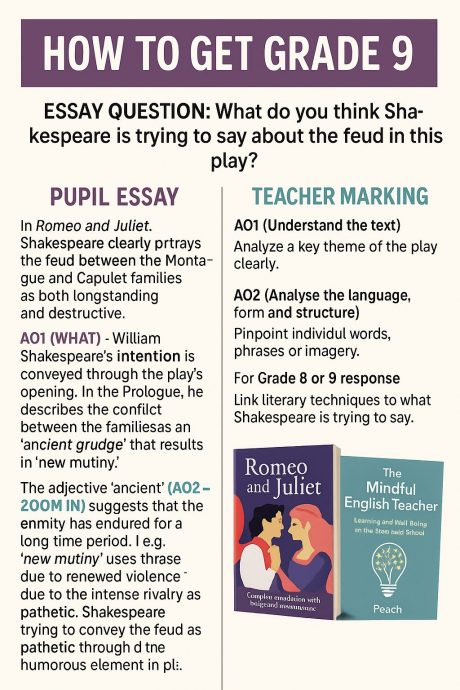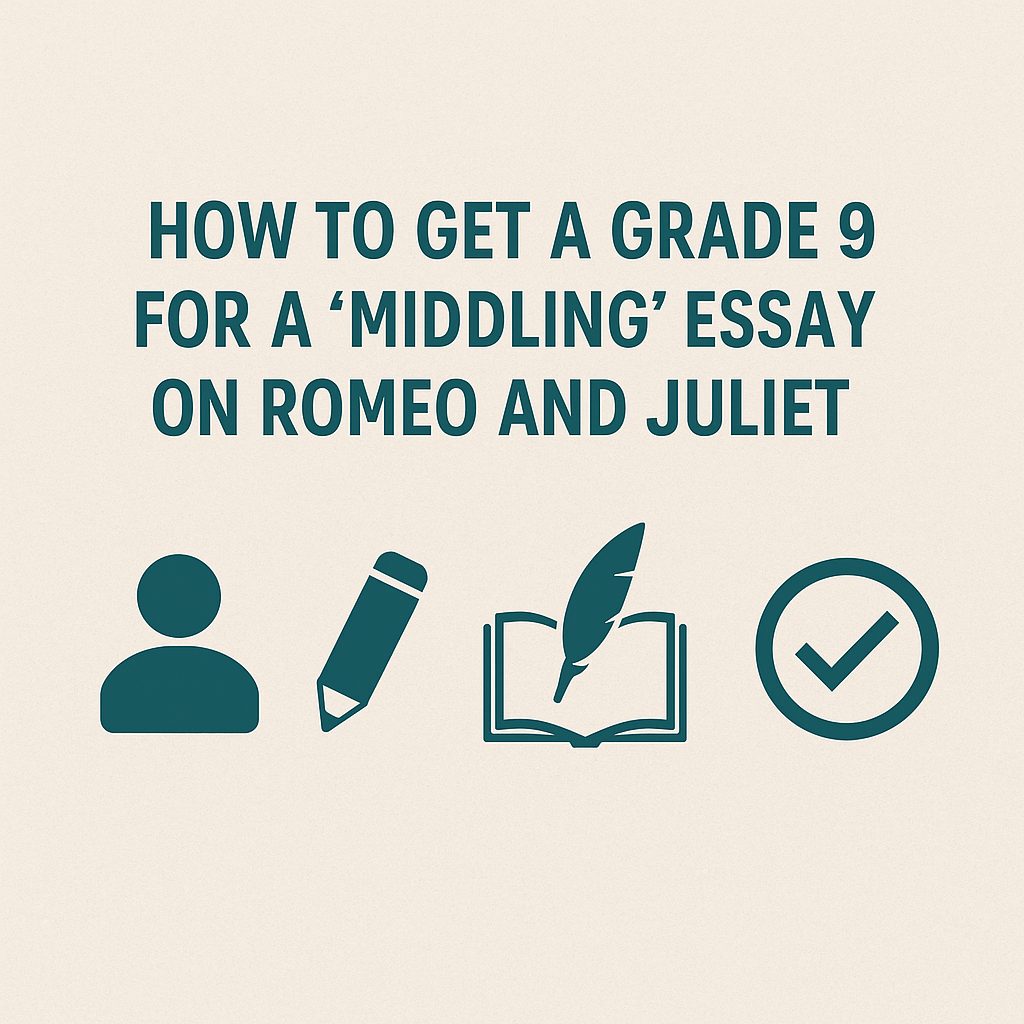
With Teacher Commentary, Grade 8–9 Guidance, and Assessment Objective Tips
Question: What do you think Shakespeare is trying to say about the feud in Romeo and Juliet?
🗝️ Key
- 📝 PUPIL ESSAY – Sample student writing
- 📌 TEACHER MARKING & GUIDANCE – Comments, AO links, and grade 8–9 tips
📝 PUPIL ESSAY INTRODUCTION
William Shakespeare presents the feud between the Montagues and Capulets as destructive, childish, and ultimately tragic. He wants his audience to see the pointlessness of inherited hate and the damage it causes.
📌 TEACHER MARKING (AO1)
✅ Clear response to the question, showing understanding of the play’s main theme.
🔑 Grade 8–9 Tip: Introduce a more complex interpretation. For example:
Shakespeare uses the feud to expose how performative honour, toxic masculinity, and intergenerational conflict cause irreversible damage to society.
Add a reference to context (AO3)—e.g. Elizabethan anxieties about rebellion.
📝
From the Prologue:
“From ancient grudge break to new mutiny.”
This tells us the feud has been going on for ages and still causes violence. “Grudge” is a strong word suggesting long-lasting hatred.
📌 TEACHER MARKING (AO1, AO2)
✅ Appropriate quote and some analysis.
🔑 Grade 8–9 Tip: Go further with language analysis and contextual framing. Try this:
“Ancient” aligns the feud with outdated, inherited values, suggesting Shakespeare critiques tradition that lacks reason. ‘Mutiny’ implies chaos—something Elizabethan rulers feared greatly.”
Use the 5Ws to deepen AO3 understanding.
📝
In Act 1 Scene 1, a Capulet servant says:
“I do bite my thumb, sir.”
This minor insult causes a fight. Shakespeare is showing how pathetic the feud is—just a gesture can spark violence.
📌 TEACHER MARKING (AO2)
✅ Good link between small gesture and larger theme.
🔑 Grade 8–9 Tip: Link to dramatic irony and tone:
Shakespeare uses low comedy and slapstick here to highlight the absurdity of honour culture. Audiences are invited to laugh—but also to reflect on the real consequences of petty pride.
You could also comment on form—how the escalation is built into the structure of the scene.
📝
The Prince says:
“You men, you beasts!”
He compares the fighters to animals. This shows how the feud is ruining society.
📌 TEACHER MARKING (AO2, AO3)
✅ Solid use of metaphor and social critique.
🔑 Grade 8–9 Tip: Analyse the double audience impact—on characters and viewers:
The insult “beasts” strips noblemen of their humanity. For Elizabethan audiences, this is deeply shaming, linking ungoverned emotion with social disorder. Shakespeare critiques masculine aggression and public violence.
Tie to fears about status, authority, and peace in Shakespeare’s own time.
📝
The Prologue also tells us:
“A pair of star-cross’d lovers take their life.”
This suggests fate is against them. Maybe Shakespeare is saying that because of the feud, their love was doomed.
📌 TEACHER MARKING (AO1, AO2)
✅ Thoughtful link between fate and the feud.
🔑 Grade 8–9 Tip: Analyse cosmic imagery and structure:
“Star-cross’d” combines astrology and tragedy. Shakespeare opens with this image to frame the play as inevitable—yet he also shows how human choices (driven by the feud) make that fate real.
Use terminology like prolepsis or dramatic foreshadowing to hit AO2 higher levels.
📝
When Mercutio dies, he says:
“A plague o’ both your houses!”
He blames both families. This shows how the feud leads to death.
📌 TEACHER MARKING (AO1, AO2, AO3)
✅ Excellent quote choice—key turning point.
🔑 Grade 8–9 Tip: Comment on symbolism and context:
“Plague” is not only literal but symbolic of moral rot. Shakespeare draws on fears of actual disease (like the plague of 1593) to criticise how unchecked hatred infects everyone—including innocent bystanders like Mercutio.
Contextual insight here can really lift your AO3 mark.
📝
Friar Lawrence hopes the feud can end:
“Turn your households’ rancour to pure love.”
This shows he wants Romeo and Juliet’s marriage to bring peace. But it doesn’t.
📌 TEACHER MARKING (AO1, AO2)
✅ Shows character motivation clearly.
🔑 Grade 8–9 Tip: Analyse juxtaposition and irony:
The contrast between “rancour” and “pure love” reflects the Friar’s idealism. Shakespeare uses him to show that rational hope is no match for deep-rooted conflict. The failure of this plan is tragic irony.
You might also comment on the Friar as a failed peacemaker, linking to AO3: religious authority, fate, and moral responsibility.
📝
At the end, Capulet says:
“O brother Montague, give me thy hand.”
This shows the families make peace, but only after their children die.
📌 TEACHER MARKING (AO1, AO2, AO3)
✅ Clear understanding of final reconciliation.
🔑 Grade 8–9 Tip: Reflect on symbolism and tragedy:
The handshake symbolises public reconciliation—but it is hollow. Shakespeare ends not with celebration, but grief. The audience is left to reflect on how peace has come far too late.
AO3 link: Elizabethan fears about civil disorder; peace won through sacrifice reflects a warning to audiences.
🧠 Final Advice: How to Push into Grades 8–9
| AO | What to Add to Reach 8–9 |
|---|---|
| AO1 | Use a clearly structured argument. Make sophisticated links between ideas across the play. Go beyond ‘what happens’ to ‘why it matters’. |
| AO2 | Use precise terminology (metaphor, irony, foreshadowing). Analyse individual words and phrases. Comment on form and structure. |
| AO3 | Apply the 5Ws consistently. Show how Shakespeare’s language reflects Elizabethan beliefs about honour, fate, religion, and gender. Compare how different audiences might react. |
📚 Study Further with These Two Supportive Guides
📙 Romeo and Juliet: The Study Guide Edition (The Complete Play with Integrated Study Notes and Modern Translation)
A full version of the play with translation, commentary, and analysis. Perfect for GCSE students aiming for top grades.
🧘 The Mindful English Teacher: Your Guide to Learning and Wellbeing
A practical guide for teachers who want to bring emotional awareness and deeper thinking into the English classroom. Includes student-friendly strategies for analysis and writing.


Leave a Reply